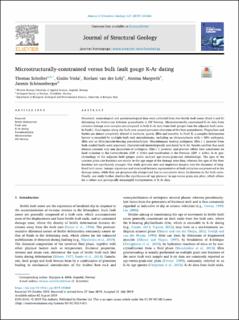| dc.contributor.author | Scheiber, Thomas | |
| dc.contributor.author | Viola, Giulio | |
| dc.contributor.author | van der Lelij, Roelant | |
| dc.contributor.author | Margreth, Annina | |
| dc.contributor.author | Schönenberger, Jasmin | |
| dc.coverage.spatial | Norway | en_US |
| dc.date.accessioned | 2020-04-17T06:57:47Z | |
| dc.date.available | 2020-04-17T06:57:47Z | |
| dc.date.created | 2019-10-08T14:15:22Z | |
| dc.date.issued | 2019 | |
| dc.identifier.citation | Scheiber, T., Viola, G., van der Lelij, R., Margreth, A., & Schönenberger, J. (2019). Microstructurally-constrained versus bulk fault gouge K-Ar dating. Journal of Structural Geology, 127. | en_US |
| dc.identifier.issn | 0191-8141 | |
| dc.identifier.uri | https://hdl.handle.net/11250/2651403 | |
| dc.description.abstract | Structural, mineralogical and geochronological data were collected from two brittle fault zones (Fault I and II) deforming the Ordovician Rolvsnes granodiorite in SW Norway. Microstructurally-constrained K–Ar data from cohesive damage zone samples are compared to bulk K–Ar data from fault gouges from the adjacent fault cores. In Fault I, fluid ingress along the fault core caused pervasive alteration of the host granodiorite. Plagioclase and biotite are almost completely altered to kaolinite, quartz, illite and smectite. In Fault II, a complex deformation history is recorded by multiple fault rock microdomains, including an ultracataclasite with >50% authigenic illite and an illite/jarosite-bearing pseudotachylyte. Microdomains hosting authigenic illite (±jarosite) from both studied faults were separated, characterized mineralogically and dated by K–Ar. Results confirm that each domain contains only one generation of authigenic illite (±jarosite), and provide robust time constraints on fault initiation in the Carboniferous (339 ± 8 Ma) and reactivation in the Permian (289 ± 6 Ma). K–Ar geochronology of the adjacent fault gouges yields inclined age-versus-grain-size relationships. The ages of the coarsest grain size fractions are similar to the age range of the damage zone data, whereas the ages of the finer fractions are significantly younger. Our study provides new and important insights into the dynamics of long-lived fault zones: Isotopic signatures and structural features representative of fault initiation are preserved in the damage zones, while they are progressively overprinted due to cumulative strain localization in the fault cores. Finally, our study further clarifies the significance of ‘age plateaus’ in age-versus-grain-size plots, which allows for a robust and geologically meaningful interpretation of K–Ar data. | en_US |
| dc.language.iso | eng | en_US |
| dc.publisher | Elsevier | en_US |
| dc.rights | Attribution-NonCommercial-NoDerivatives 4.0 Internasjonal | * |
| dc.rights.uri | http://creativecommons.org/licenses/by-nc-nd/4.0/deed.no | * |
| dc.subject | brittle deformation | en_US |
| dc.subject | fault rock | en_US |
| dc.subject | K–Ar dating | en_US |
| dc.subject | pseudotachylyte | en_US |
| dc.subject | microstructure | en_US |
| dc.title | Microstructurally-constrained versus bulk fault gouge K-Ar dating | en_US |
| dc.type | Peer reviewed | en_US |
| dc.type | Journal article | en_US |
| dc.description.version | publishedVersion | en_US |
| dc.rights.holder | © 2019 The Authors | en_US |
| dc.source.volume | 127 | en_US |
| dc.source.journal | Journal of Structural Geology | en_US |
| dc.identifier.doi | 10.1016/j.jsg.2019.103868 | |
| dc.identifier.cristin | 1734986 | |
| cristin.ispublished | true | |
| cristin.fulltext | original | |
| cristin.qualitycode | 2 | |

